View in other NatureServe Network Field Guides
NatureServe
Montana
Utah
Wyoming
Idaho
Wisconsin
British Columbia
South Carolina
Yukon
California
New York
Paddlefish - Polyodon spathula
State Rank Reason (see State Rank above)
Species is widely distributed is managed and stable and faces a number of low level threats
General Description
The Paddlefish is an ancient, mostly cartilaginous fish with a smooth skin. It is a close relative of sturgeons. Although it is sometimes called a spoonbill or spoonbill cat, it is not closely related to catfish. Most species of Paddlefish are now extinct, and fossil Paddlefish from 60 million years ago have been found in the Missouri River basin near Fort Peck Reservoir, Montana (
Montana AFS Species Status Account).
Montana is home to one of the few remaining self-sustaining populations of Paddlefish, and harbors the largest individual fish as well. Specimens have been taken weighing up to 150 pounds.
For a comprehensive review of the ecology, conservation status, threats, and management of this and other Montana fish species of concern, please see
Montana Chapter of the American Fisheries Society Species of Concern Status Reviews.Diagnostic Characteristics
Paddlefish are readily identified by the long paddle-like snout, long, tapered gill covers, and the "backbone" bent up into the upper lobe of the tail fin. The body is smooth and virtually scaleless (Holton and Johnson 2003).
Species Range
Montana Range
Range Descriptions
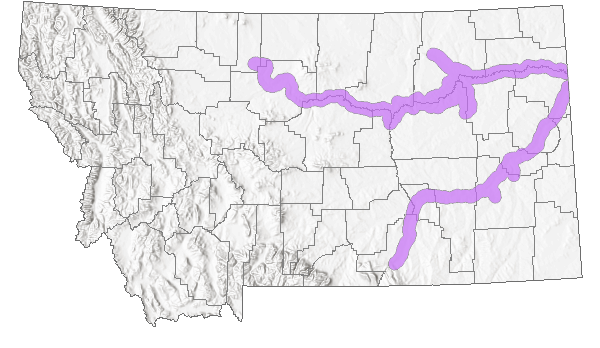
 Native
Native
Western Hemisphere Range

Range Comments
In Montana, paddlefish are found in the Yellowstone River as far upriver as Forsyth as well as the Missouri River above and below Fort Peck Dam. Fish above Fort Peck Dam (known as the Fort Peck stock) are now isolated from fish below the dam, although some upriver fish can pass downstream. An important recreational snag fishery exists for this stock in areas near the Fred Robinson Bridge. The downstream fish are part of the population inhabiting the Yellowstone River and Lake Sakakawea, known as the Yellowstone-Sakakawea stock.
Observations in Montana Natural Heritage Program Database
Number of Observations: 935
(Click on the following maps and charts to see full sized version)
Map Help and Descriptions
Relative Density
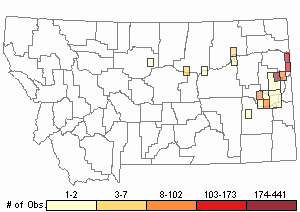
Recency
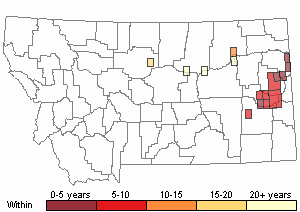
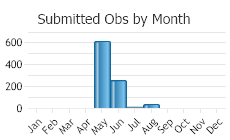

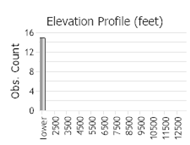 (Observations spanning multiple months or years are excluded from time charts)
(Observations spanning multiple months or years are excluded from time charts)
Migration
Spawning migrations are tied closely with the timing of spring highwater.
Habitat
Habitat includes slow or quiet waters of large rivers or impoundments. They spawn on the gravel bars of large rivers during spring high water. Paddlefish tolerate, or perhaps seek, turbid water (Holton and Johnson 2003).
Food Habits
Young-of-year Paddlefish will "bite" at small food particles, but eventually (within a year) switch to filtering for food as they grow and need more food. The young Paddlefish are pale, nearly transparent, and swim in loose groups, preferring to feed on a large zooplankton called
Leptodora kindtii (
Montana AFS Species Status Account).
When feeding, adult Paddlefish swim with their mouths wide open and filter the zooplankton from the water with filament-like gill rakers. In some places, adult Paddlefish also filter aquatic insects and, occasionally, tiny fish. Recent research has shown conclusively that the paddle is an electrosensory structure that functions much like an antenna. It detects weak electric fields. The paddle, head and gill flaps are covered with tiny sensory pores that it uses to detect food organisms. The paddle may also function to keep the fish level in the water while it is continually moving and feeding. The paddle would then provide "lift" much like airplane wings to keep the fish from nose-diving to the bottom (
Montana AFS Species Status Account).
Ecology
The paddle is not developed at all on very young fish, but by the time the fish reaches 8 inches, the paddle may be half the total length of the fish. As the fish gets larger, the paddle becomes relatively shorter compared to the total length of the fish. Adult Paddlefish can live without a paddle, but there is some evidence that the fish that have lost their paddles feed less efficiently and are thinner than those with their paddles intact (
Montana AFS Species Status Account).
Most of the large fish (40 to 90 pounds) at intake are females which range from 15 to 50 years of age and average about 26 years. Most of the small fish (10 to 40 pounds) are males that range from 9 to 50 years old and average about 16 years. Paddlefish can occasionally live past age 50, with fish in the Yellowstone and upper Missouri River living longer than those farther south (
Montana AFS Species Status Account).
The Montana record is 142 1/2 pounds, caught above Fort Peck, in 1973. Fish of the Yellowstone-Sakakawea stock seldom exceed 100 pounds. Fish living in lakes and reservoirs often grow faster and larger than those living solely in rivers (
Montana AFS Species Status Account).
Reproductive Characteristics
When Paddlefish mature, at about age 9 to 10 for males and age 16 to 17 for females, they migrate up river to spawn. Adult fish do not as a rule die after spawning, but we know from tagging studies that a given female only spawns about every 3 years, and a given male about every 2 years (
Montana AFS Species Status Account).
The males and females have evolved different strategies for reproducing and passing on their genes to the next generation. The larger a female is, the more eggs she can produce, and the more young Paddlefish she will probably produce. A male gains less by becoming large because even a small male will have millions of sperm--enough to fertilize all of the eggs from the largest female. It is preferable for males to mature at a younger age than females so they may reproduce more often, as opposed to taking the time to grow large, risking death before they spawn. Conversely, a female benefits more from the gamble she takes in delaying maturity because of the additional eggs she will produce (
Montana AFS Species Status Account).
Paddlefish spawn in rivers during high water periods in late spring or early summer (May to June). In the Yellowstone River, most evidence indicates that downriver areas near Sidney and Fairview are primary spawning areas, and to a lesser extent farther upriver toward Intake. Many spawning sites are not yet well identified, however, and Paddlefish undoubtedly spawn over gravel bars and areas of finer substrate in several areas of the Yellowstone River (
Montana AFS Species Status Account).
Management
Paddlefish stocks in Montana are adequate to support a recreational fishery. Current research and monitoring are designed to prevent over-harvest and insure a sustainable wild fishery. Managers accurately estimate the ages of the fish caught in the fisheries. Changes in the age structure of the population are being monitored to insure that young fish are added, and old fish retained, in the populations (
Montana AFS Species Status Account).
The aging of the population, along with decline in fishing success rates and higher harvest of tagged (adult) Paddlefish account for the reduction of the Paddlefish limit from two per person per year to one per person per year in both Montana and North Dakota, and the proposed reduction to a 1,000 fish annual harvest cap per state. The aim is to stabilize the population at 30,000 fish and avoid over-harvest of this unique, slowly-maturing species. With a fish like Paddlefish that matures at an old age, has a record of reproductive problems, and is not seen often until it is large and on its upstream migration, we need to watch constantly for signs of over-harvest (
Montana AFS Species Status Account).
The Yellowstone-Sakakawea stock does not recognize state boundaries. For this reason, management of the stock occurs under a Cooperative Management Plan between the Montana Department of Fish, Wildlife and Parks and the North Dakota Game and Fish Department (
Montana AFS Species Status Account).
Stewardship Responsibility
References
- Literature Cited AboveLegend:
 View Online Publication
View Online Publication Holton, G.D. and H.E. Johnson. 2003. A field guide to Montana fishes. 3rd edition. Montana Fish, Wildlife & Parks, Helena, MT. 95 pp.
Holton, G.D. and H.E. Johnson. 2003. A field guide to Montana fishes. 3rd edition. Montana Fish, Wildlife & Parks, Helena, MT. 95 pp. Lee, D.S., C.R. Gilbert, C.H. Hocutt, R.E. Jenkins, D. E. McAllister, J. R. Stauffer, Jr. 1980. Atlas of North American freshwater fishes. North Carolina State Musuem of Natural History. 867 p.
Lee, D.S., C.R. Gilbert, C.H. Hocutt, R.E. Jenkins, D. E. McAllister, J. R. Stauffer, Jr. 1980. Atlas of North American freshwater fishes. North Carolina State Musuem of Natural History. 867 p. Montana Chapter of the American Fisheries Society species status accounts.
Montana Chapter of the American Fisheries Society species status accounts. Scott, W.B. and E.J. Crossman. 1973. Rainbow trout, Kamloops trout, Steelhead trout Salmo gairdneri Richardson. pp. 184-191. In: Freshwater fishes of Canada. Ottawa, Canada: Fisheries Research Board of Canada, Bulletin 184. 966 p.
Scott, W.B. and E.J. Crossman. 1973. Rainbow trout, Kamloops trout, Steelhead trout Salmo gairdneri Richardson. pp. 184-191. In: Freshwater fishes of Canada. Ottawa, Canada: Fisheries Research Board of Canada, Bulletin 184. 966 p.
- Additional ReferencesLegend:
 View Online Publication
View Online Publication
Do you know of a citation we're missing? Berg, R. 1980. Spoonbill, like the rivers it inhabits, the paddlefish is strong and powerful - but vulnerable to exploitation. Montana Outdoors March/April: 11-13, 21.
Berg, R. 1980. Spoonbill, like the rivers it inhabits, the paddlefish is strong and powerful - but vulnerable to exploitation. Montana Outdoors March/April: 11-13, 21. Branson, B.A. 1974. The American paddlefish: signs of distress. The Environmental Journal, National Parks & Conservation Magazine January: 21-23.
Branson, B.A. 1974. The American paddlefish: signs of distress. The Environmental Journal, National Parks & Conservation Magazine January: 21-23. Caricaburu, L. Paddlefish may be 'threatened' but federal listing might not doom Glendive's caviar project. Great Falls, MT: Great Falls Tribune. 18 April 1990. pp. 1C-2C.
Caricaburu, L. Paddlefish may be 'threatened' but federal listing might not doom Glendive's caviar project. Great Falls, MT: Great Falls Tribune. 18 April 1990. pp. 1C-2C. Carlson, D.M. and P.S. Bonislawsky. 1981. The paddlefish (Polyodon spathula) fisheries of the midwestern United States. Fisheries 6(2):17-27.
Carlson, D.M. and P.S. Bonislawsky. 1981. The paddlefish (Polyodon spathula) fisheries of the midwestern United States. Fisheries 6(2):17-27. Craig, V.E. 1952. A story of fish production as it applies to Montana. M.Sc. Thesis. Bozeman, MT: Montana State University. 92 p.
Craig, V.E. 1952. A story of fish production as it applies to Montana. M.Sc. Thesis. Bozeman, MT: Montana State University. 92 p. Dieterman, D.J., M.P. Ruggles, M.L. Wildhaber, and D.L. Galat (eds). 1996. Population structure and habitat use of benthic fishes along the Missouri and Lower Yellowstone Rivers. 1996 Annual report of Missouri River Benthic Fish Study PD-95-5832 to U.S. Army Corps of Engineers and U.S. Bureau of Reclamation. 238 p.
Dieterman, D.J., M.P. Ruggles, M.L. Wildhaber, and D.L. Galat (eds). 1996. Population structure and habitat use of benthic fishes along the Missouri and Lower Yellowstone Rivers. 1996 Annual report of Missouri River Benthic Fish Study PD-95-5832 to U.S. Army Corps of Engineers and U.S. Bureau of Reclamation. 238 p. Dillard, J.G., L.K. Graham, T.R. Russell, and B.K. Bassett. 1986. Paddlefish - A threatened resource? Fisheries 11(5):18-19.
Dillard, J.G., L.K. Graham, T.R. Russell, and B.K. Bassett. 1986. Paddlefish - A threatened resource? Fisheries 11(5):18-19. Duncan, M.B. 2019. Distributions, abundances, and movements of small, nongame fishes in a large Great Plains river network. Ph.D. Dissertation. Bozeman, MT: Montana State University. 255 p.
Duncan, M.B. 2019. Distributions, abundances, and movements of small, nongame fishes in a large Great Plains river network. Ph.D. Dissertation. Bozeman, MT: Montana State University. 255 p. Elser, A. 1973. The great paddlefish puzzle. Montana Outdoors May/June:30-34.
Elser, A. 1973. The great paddlefish puzzle. Montana Outdoors May/June:30-34. Elser, A. Paddlefish mystery. Helena, MT: The Independent Record. 18 July 1973.
Elser, A. Paddlefish mystery. Helena, MT: The Independent Record. 18 July 1973. Fischer, H. 1978. Behold the paddlefish, a prehistoric wonder quickly fades as dams destroy its spawning grounds. Defenders Magazine 53(1):24-26.
Fischer, H. 1978. Behold the paddlefish, a prehistoric wonder quickly fades as dams destroy its spawning grounds. Defenders Magazine 53(1):24-26. Grisak, G.G. 1996. The status and distribution of the sicklefin chub in the middle Missouri River, Montana. M.Sc. Thesis. Bozeman, MT: Montana State University. 77 p.
Grisak, G.G. 1996. The status and distribution of the sicklefin chub in the middle Missouri River, Montana. M.Sc. Thesis. Bozeman, MT: Montana State University. 77 p. Hagland, B. 1983. Paddlefish at CMR are really living fossils. Montana Wildlife Jan.-Feb. 1983. 2 p.
Hagland, B. 1983. Paddlefish at CMR are really living fossils. Montana Wildlife Jan.-Feb. 1983. 2 p. Halbert, J. Paddlefishing: golden eggs may be too big an attraction. Miles City, MT: Miles City Star. 10 September 1980. 4 p.
Halbert, J. Paddlefishing: golden eggs may be too big an attraction. Miles City, MT: Miles City Star. 10 September 1980. 4 p. Holton, G.D. 1981. Identification of Montana's most common game and sport fishes. Montana Outdoors May/June reprint. 8 p.
Holton, G.D. 1981. Identification of Montana's most common game and sport fishes. Montana Outdoors May/June reprint. 8 p. Independent Record. Mysterious fish paddles back into State's waters. Helena, MT: The Independent Record. 4 August 1975. 1 p.
Independent Record. Mysterious fish paddles back into State's waters. Helena, MT: The Independent Record. 4 August 1975. 1 p. Joslin, Gayle, and Heidi B. Youmans. 1999. Effects of recreation on Rocky Mountain wildlife: a review for Montana. [Montana]: Montana Chapter of the Wildlife Society.
Joslin, Gayle, and Heidi B. Youmans. 1999. Effects of recreation on Rocky Mountain wildlife: a review for Montana. [Montana]: Montana Chapter of the Wildlife Society. Kallemeyn, L.W. 1975. Paddlefish maybe a future after all. South Dakota Conservation Digest march/April 1975:12-15.
Kallemeyn, L.W. 1975. Paddlefish maybe a future after all. South Dakota Conservation Digest march/April 1975:12-15. Kamm, W. 1989. Paddlefishing hard work that's fun. Warden's Magazine Summer 1989:8-10.
Kamm, W. 1989. Paddlefishing hard work that's fun. Warden's Magazine Summer 1989:8-10. Lindler, B. 1990. Glendive hopes caviar will be big business. Great Falls, MT: Great Falls Tribune. 10 June 1990. pp. 1A, 10A.
Lindler, B. 1990. Glendive hopes caviar will be big business. Great Falls, MT: Great Falls Tribune. 10 June 1990. pp. 1A, 10A. McCafferty, K. 1990. Muddy waters. Field and Stream Magazine August:48-49, 83.
McCafferty, K. 1990. Muddy waters. Field and Stream Magazine August:48-49, 83. Mecklenburg, M. Scientists can learn more about paddlefish. Sidney, MT: Sidney Herald-Leader. 30 June 1991. p. 6C
Mecklenburg, M. Scientists can learn more about paddlefish. Sidney, MT: Sidney Herald-Leader. 30 June 1991. p. 6C Megargle, D.J. 1997. Temporal variation in food selection of shovelnose sturgeon in the Missouri River above Fort Peck Reservoir, MT. M.Sc. Thesis. Bozeman, MT: Montana State University. 127 p.
Megargle, D.J. 1997. Temporal variation in food selection of shovelnose sturgeon in the Missouri River above Fort Peck Reservoir, MT. M.Sc. Thesis. Bozeman, MT: Montana State University. 127 p. Merwin, J. 1973. Research gives paddlefish a chance. South Dakota Conservation Digest pp. 12-14.
Merwin, J. 1973. Research gives paddlefish a chance. South Dakota Conservation Digest pp. 12-14. Montana Department of Fish, Wildlife and Parks. 1989. Northeast Montana Warmwater Ecosystem Investigations: project period 7/1/88 through 6/30/89. Proj.# F-46-R-2; Job# V-e. 21p.
Montana Department of Fish, Wildlife and Parks. 1989. Northeast Montana Warmwater Ecosystem Investigations: project period 7/1/88 through 6/30/89. Proj.# F-46-R-2; Job# V-e. 21p. Montana Fish and Game Department. 1966. We're learning about paddlefish. Montana Outdoors 1(3):1-3.
Montana Fish and Game Department. 1966. We're learning about paddlefish. Montana Outdoors 1(3):1-3. MT Fish, Wildlife & Parks. The paddlefish - senior citizen of the Yellowstone and Missouri Rivers.
MT Fish, Wildlife & Parks. The paddlefish - senior citizen of the Yellowstone and Missouri Rivers. MTFWP, Fisheries Division. 1988. Yellowstone River paddlefish investigations. Project # F-46-R-1; job # III-c. 9 pp.
MTFWP, Fisheries Division. 1988. Yellowstone River paddlefish investigations. Project # F-46-R-1; job # III-c. 9 pp. Mullins, M.S. 1991. Biology and predator use of cisco (Coregonus artedi) in Fort Peck Reservoir, Montana. M.Sc. Thesis. Bozeman, MT: Montana State University. 68 p.
Mullins, M.S. 1991. Biology and predator use of cisco (Coregonus artedi) in Fort Peck Reservoir, Montana. M.Sc. Thesis. Bozeman, MT: Montana State University. 68 p. Pasch, R.W., Hackney, P.A. and J.A. Holbrook II. 1978. Ecology of paddlefish in Old Hickory Reservoir, Tennessee, with emphasis on 1st year life history. Trans. Amer. Fish. Soc. 109:157-167.
Pasch, R.W., Hackney, P.A. and J.A. Holbrook II. 1978. Ecology of paddlefish in Old Hickory Reservoir, Tennessee, with emphasis on 1st year life history. Trans. Amer. Fish. Soc. 109:157-167. Penkal, R.F. 1981. Life history and flow requirements of paddlefish, shovelnose sturgeon, channel catfish, and other fish in the lower Yellowstone River system. Montana Department of Fish, Wildlife, and Parks. 53 p.
Penkal, R.F. 1981. Life history and flow requirements of paddlefish, shovelnose sturgeon, channel catfish, and other fish in the lower Yellowstone River system. Montana Department of Fish, Wildlife, and Parks. 53 p. Pflieger, W.L. 1975. Paddlefish, Polyodon spathula (Walbaum). pp. 64-65. In: The Fishes of Missouri. Jefferson City, MO: Missouri Department of Conservation. 343 p.
Pflieger, W.L. 1975. Paddlefish, Polyodon spathula (Walbaum). pp. 64-65. In: The Fishes of Missouri. Jefferson City, MO: Missouri Department of Conservation. 343 p. Priest, J.P. 1977. Bowhunting, the prehistoric paddlefish. Outdoor Corps, U.S. Army Corps of Engineers, July 1977. 5 p.
Priest, J.P. 1977. Bowhunting, the prehistoric paddlefish. Outdoor Corps, U.S. Army Corps of Engineers, July 1977. 5 p. Purkett, C. A. 1963. The paddlefish fishery of the Osage River and the Lake of the Ozarks, Missouri. Transactions of the American Fisheries Society 92:239-244.
Purkett, C. A. 1963. The paddlefish fishery of the Osage River and the Lake of the Ozarks, Missouri. Transactions of the American Fisheries Society 92:239-244. Purkett, C.A. Jr. 1961. Reproduction and early development of the paddlefish. Transactions of the American Fisheries Society 90(2): 125-129.
Purkett, C.A. Jr. 1961. Reproduction and early development of the paddlefish. Transactions of the American Fisheries Society 90(2): 125-129. Rehwinkel, B.J. 1975. The fishery for Paddlefish at Intake, Montana, during 1973 and 1974. M.Sc. Thesis. Bozeman, Montana: Montana State University. 37 p.
Rehwinkel, B.J. 1975. The fishery for Paddlefish at Intake, Montana, during 1973 and 1974. M.Sc. Thesis. Bozeman, Montana: Montana State University. 37 p. Rehwinkel, B.J. 1978. The fishery for paddlefish at Intake, Montana during 1973 and 1974. Transactions of the American Fisheries Society 107(2):263-268.
Rehwinkel, B.J. 1978. The fishery for paddlefish at Intake, Montana during 1973 and 1974. Transactions of the American Fisheries Society 107(2):263-268. Robinson, J.W. 1966. Observations on the life history, movement, and harvest of the Paddlefish, Polyodon spathula in Montana. M.Sc. Thesis. Bozeman, Montana: Montana State University. 17 p.
Robinson, J.W. 1966. Observations on the life history, movement, and harvest of the Paddlefish, Polyodon spathula in Montana. M.Sc. Thesis. Bozeman, Montana: Montana State University. 17 p. Robinson, J.W. 1966. Observations on the life history, movement, and harvest of the paddlefish, Polyodon spathula, in Montana. Proceedings of the Montana Academy of Sciences 26:33-44.
Robinson, J.W. 1966. Observations on the life history, movement, and harvest of the paddlefish, Polyodon spathula, in Montana. Proceedings of the Montana Academy of Sciences 26:33-44. Scarnecchia, D.L., T.W. Gengerke, and C.T. Moen. 1989. Rationale for a harvest slot limit for paddlefish in the upper Mississippi River. North American Journal of Fisheries Management 9:477-487.
Scarnecchia, D.L., T.W. Gengerke, and C.T. Moen. 1989. Rationale for a harvest slot limit for paddlefish in the upper Mississippi River. North American Journal of Fisheries Management 9:477-487. Sheely, T. Paddlers run early in Missouri River. Montana Fishing and Hunting News. 20 April 1974. 2 p.
Sheely, T. Paddlers run early in Missouri River. Montana Fishing and Hunting News. 20 April 1974. 2 p. Stash, S.W. 2001. Distribution, relative abundance, and habitat associations of Milk River fishes related to irrigation diversion dams. M.Sc. Thesis. Bozeman, MT: Montana State University. 82 p.
Stash, S.W. 2001. Distribution, relative abundance, and habitat associations of Milk River fishes related to irrigation diversion dams. M.Sc. Thesis. Bozeman, MT: Montana State University. 82 p. Unkenholz, D. 1986. Paddlefish on the wane. South Dakota Conservation Digest 53(6):11-13.
Unkenholz, D. 1986. Paddlefish on the wane. South Dakota Conservation Digest 53(6):11-13. USDI Bureau of Land Management. No date. Fishes of the Miles city, Montana BLM District. Miles City, MT: Miles City BLM District pamphlet. 12 p.
USDI Bureau of Land Management. No date. Fishes of the Miles city, Montana BLM District. Miles City, MT: Miles City BLM District pamphlet. 12 p. Vasetskiy, S.G. 1971. Fishes of the family Polyodontidae. Journal of Ichthyology 11(1):18-31.
Vasetskiy, S.G. 1971. Fishes of the family Polyodontidae. Journal of Ichthyology 11(1):18-31. Walcheck, K. Spring signals the spawning run of the paddlefish. Helena, MT: The Independent Record. 7 May 1982. p. 14C.
Walcheck, K. Spring signals the spawning run of the paddlefish. Helena, MT: The Independent Record. 7 May 1982. p. 14C. Willard, J. Outdoor Montana paddlefish on increase. Helena, MT: The Independent Record. 4 January 1976. 1 p.
Willard, J. Outdoor Montana paddlefish on increase. Helena, MT: The Independent Record. 4 January 1976. 1 p. Willard, J. Outdoor Montana the first paddlefish. Helena, MT: The Independent Record. 13 January 1974. 1 p.
Willard, J. Outdoor Montana the first paddlefish. Helena, MT: The Independent Record. 13 January 1974. 1 p. Williams, J.E., J.E. Johnson, D.A. Hendrickson, S. Contreras-Balderas, J.D. Williams, M. Navarro-Mendoza, D.E. McAllister, and J.E. Deacon. 1989. Fishes of North America endangered, threatened, or of special concern: 1989. Fisheries 14(6):2-20.
Williams, J.E., J.E. Johnson, D.A. Hendrickson, S. Contreras-Balderas, J.D. Williams, M. Navarro-Mendoza, D.E. McAllister, and J.E. Deacon. 1989. Fishes of North America endangered, threatened, or of special concern: 1989. Fisheries 14(6):2-20.
- Web Search Engines for Articles on "Paddlefish"
- Additional Sources of Information Related to "Fish"





